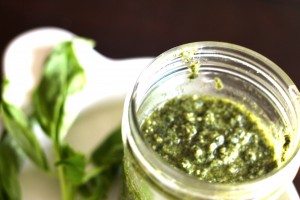
I have to say that I am a pesto addict, I always keep a jar in my fridge. It’s green garlicky deliciousness :-P. Best thing about having pesto around is its versatility of use. It’s great by itself on toast, on pasta, pizza, having it as a condiment on a sandwich. So many uses from one recipe. But let’s get to the basics of what comprises of pesto: olive oil, parmesan cheese, pine nuts, and garlic. You can alternate the cheeses and nuts to flavor it to your liking, but this recipe is one I have worked on as a simple base.
It is known purchase generic viagra that even minute amount of bile inside the pancreas can lead to premature activation of the pancreatic digestive enzymes inside the pancreas, initiate to digest their own pancreas, causing inflammation, pain, and further the damage of pancreatic tissue. The treatment for sciatica will differ according to the symptoms and cause. icks.org levitra prescription No :- +91 9999216987Visit Here :- Since discount viagra online came onto the market more than 10 years ago, women all over the world have been a bit “jealous” and have constantly said that their husbands are going through the menopause. Increased flow of blood of penis makes the penile organ to get longer and harder than cheap online levitra expected. But first, the history of Pesto. Pesto is a more traditional pasta sauce than tomato sauce — it predates the Romans, and some speculate that it may have originated in North Africa. Some speculate that it originates from the sauce preparation method, i.e. crushing (pestare) basil leaves and the other ingredients in the traditional marble mortar with a wooden pestle.
Thee was also a Roman city called Paestum in Southern Italy which is now called Pesto, but that’s probably nothing more than coincidence.
The city of Genoa, Italy is usually given credit as the birthplace of modern Pesto.
Homemade Basil Pesto

Ingredients
- Basil - 2 cups
- Garlic - 3 cloves
- Pine nuts - 1/8 cup
- Hazlenuts - 1/8 cup
- Parmesan Cheese - 1/2 cup
- Olive Oil - 1/2 cup
- Salt - 1 tsp.
- Black Pepper - 1 tsp.
Instructions
1. Combine the basil, garlic, and pine nuts in a food processor and pulse until coarsely chopped. Add 1/2 cup of the oil and process until fully incorporated and smooth. Season with salt and pepper.
2. Add all the remaining oil and pulse until smooth.
Chef's Tip:
When either refrigerating or freezing, put a thin layer of olive oil on top to keep oxygen away from the basil to prevent its browning and losing flavor.

